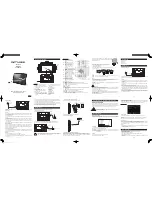
TP-6862 6/14
32 Section 6 Electrical System
6.3 Installation In Steel or
Aluminum Vessels
Installation of a generator set in a vessel constructed of
a material capable of conducting current (e.g., steel or
aluminum) is subject to considerations not normally
encountered in fiberglass or wood vessels. These
differences include equipment grounding, grounding of
neutral conductors, ground-fault protection, and
isolation of galvanic currents.
Note:
Isolated ground kits are available as options for
steel- or aluminum-hulled vessels. Consult your
local dealer/distributor for more information.
The scope of these topics is too extensive to be fully
discussed here. Consult your local marine authority for
more information.
Before installing the generator set, check the available
wiring diagrams in the operation manual to become
familiar with the electrical system.
6.4 Installation Regulations
The U.S. Coast Guard governs generator set
installation in U.S. pleasurecraft and commercial
vessels. Refer to the applicable regulations below:
U.S. Pleasurecraft Installation
Regulations
Title 33CFR, Chapter I, U.S. Coast Guard, Part 183
1. Subpart I—Electrical Equipment
2. Subpart J—Fuel Systems
U.S. Commercial Vessel Installation
Regulations
Title 46CFR, Chapter I, U.S. Coast Guard
1. Part 111—Electrical Systems
2. Part 182—Machinery Installation
m:sc:001:001
6.5 Battery
Batteries and their installation must conform to USCG
Regulations 183.420 (a) through (g). Provide generator
sets with batteries separate from the propulsion
engine’s whenever possible. The starting/charging
systems of both the generator set and the engine must
have a common negative (--) ground.
USCG Regulation 183.415, Grounding, requires
connection of a common conductor to each grounded
cranking-motor circuit. Size the conductor to match the
larger of the engine’s two battery cables. Figure 6-4 lists
recommended minimum cable sizes for generator set
battery connections at various generator set-to-battery
distances. Connecting a common conductor to each
grounded cranking motor circuit prevents the starting
motor current from using alternative electrical paths
should the cranking motor ground circuit be restricted or
open because of oxidation or loose hardware.
Alternative electrical paths include metallic fuel lines
that can pose a hazard. See Section 7 for locations of
the battery connections to the generator set.
Required Battery Cable
(Minimum)
Distance (from battery to
generator set)
2.5 m (8.3 ft.) 5 m (16.4 ft.)
Battery Voltage
12V
24V
12V
24V
40--65EOZDJ/EOZCJ
33--50EFOZDJ/EFOZCJ
# 0
# 4
# 3/0
# 2
80--99EOZDJ/EOZCJ
70--80EFOZDJ/EFOZCJ
# 2/0
# 2
# 4/0 # 1/0
125--150EOZDJ/EOZCJ
100--125EFOZDJ/EFOZCJ
# 2/0
# 2
# 4/0 # 1/0
Figure 6-4
Battery Cable Sizing Recommendations
Summary of Contents for 33-125EFOZCJ
Page 2: ...TP 6862 6 14 2...
Page 8: ...TP 6862 6 14 8 Safety Precautions and Instructions Notes...
Page 10: ...TP 6862 6 14 10 Section 1 Introduction Notes...
Page 12: ...TP 6862 6 14 12 Section 2 Location and Mounting Notes...
Page 28: ...TP 6862 6 14 28 Section 5 Fuel System Notes...
Page 34: ...TP 6862 6 14 34 Section 6 Electrical System Notes...
Page 52: ...TP 6862 6 14 52 Section 7 Installation Drawings Notes...
Page 78: ...TP 6862 6 14 78 Section 9 Paralleling Generator Sets Notes...
Page 82: ...TP 6862 6 14 82...
Page 83: ...TP 6862 6 14 83...
















































